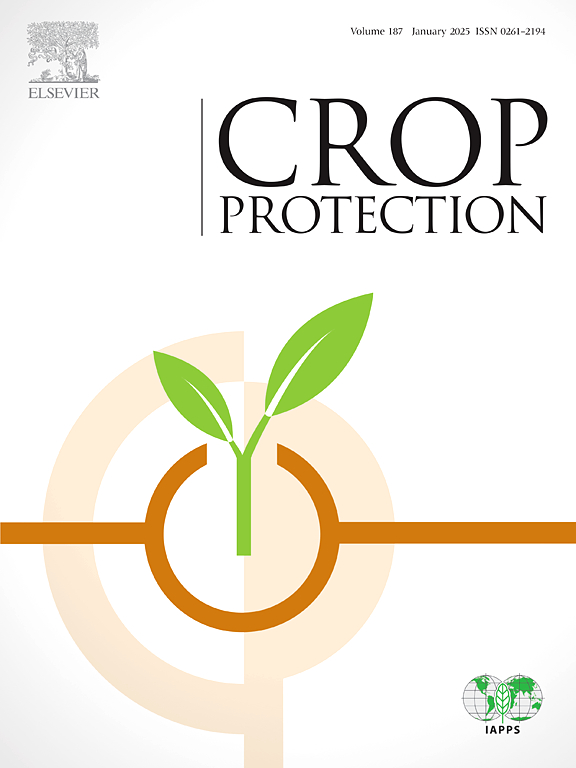系统发育分析表明,在巴西只有 Albugo rorippae 能引起辣根白锈病
IF 2.5
2区 农林科学
Q1 AGRONOMY
引用次数: 0
摘要
Armoracia rusticana 俗称辣根,是巴西南部菜肴中常见的一种十字花科调味品。2020 年,在巴西巴拉那州库里蒂巴市的一个种植区发现了叶片出现病变和白色脓疱的植物。根据系统发育研究,原产阿尔布戈被归入阿尔布戈属、脓疱属和威尔逊属。由于对巴西白锈病的病原标本还没有分子鉴定,本研究旨在确定A. rusticana白锈病的病原。收集有症状的植物以确定卵菌,并将其置于无症状植物附近进行致病性试验。接触病株的植株在接触 14 天后出现症状,而未接触病株的植株仍无症状。症状和形态的比较符合 Albugo sensu lato 的特征。经过形态测定和细胞色素 c 氧化酶亚单位 II(cox2)mtDNA 基因部分区域的序列比较,确定该卵菌为 Albugo rorippae。迄今为止,阿根廷、澳大利亚、德国、捷克共和国、波兰和罗马尼亚的 A.rusticana、Rorippa amphibia、Rorippa palustris 和 Rorippa sylvestris 上都有关于该物种的报道。根据文献记载,定殖 Armoracia sp.的 Albugo 标本定殖 Rorippa sp.的效率较低,从这两种寄主分离的标本的卵孢子也存在一些差异。因此,要确定是否存在寄主种属专一性,就必须对阿尔布戈孢子在阿摩拉西亚和罗里帕物种中的情况进行全面取样。这是巴西首次报告 A. rorippae 在 Armoracia rusticana 中的情况。本文章由计算机程序翻译,如有差异,请以英文原文为准。
Phylogenetic analyses reveal only Albugo rorippae causing white rust on horseradish in Brazil
Armoracia rusticana, commonly known as horseradish, is a Brassicaceae condiment common in southern Brazilian cuisine. In 2020, plants with leaf lesions and white pustules were observed in a cultivation area in the metropolitan region of Curitiba, state of Paraná, Brazil. Based on phylogenetic studies, Albugo sensu lato was classified into the genera Albugo, Pustula, and Wilsoniana. As there is still no molecular characterization of the specimens that cause white rust in Brazil, this study aimed to identify the causal agent of white rust in A. rusticana. Symptomatic plants were collected to identify the oomycete and placed near asymptomatic plants for the pathogenicity test. Plants exposed to the diseased plants showed symptoms 14 days after exposure, while plants without exposure to diseased plants remained asymptomatic. Comparison of symptoms and morphology matched the characteristics of Albugo sensu lato. After morphometry and sequence comparison of the partial region of the cytochrome c oxidase subunit II (cox2) mtDNA gene, the oomycete was identified as Albugo rorippae. To date, this species is reported on A. rusticana, Rorippa amphibia, Rorippa palustris, and Rorippa sylvestris in Argentina, Australia, Germany, Czech Republic, Poland, and Romania. According to the literature, the Albugo specimens that colonize Armoracia sp. have low efficiency in colonizing Rorippa sp., and there are some differences in the oospores of the specimens isolated from these two hosts. Therefore, a comprehensive sampling of Albugo sp. in Armoracia and Rorippa species is essential to determine whether there is host genus specialization. This is the first report of A. rorippae in Armoracia rusticana in Brazil.
求助全文
通过发布文献求助,成功后即可免费获取论文全文。
去求助
来源期刊

Crop Protection
农林科学-农艺学
CiteScore
6.10
自引率
3.60%
发文量
200
审稿时长
29 days
期刊介绍:
The Editors of Crop Protection especially welcome papers describing an interdisciplinary approach showing how different control strategies can be integrated into practical pest management programs, covering high and low input agricultural systems worldwide. Crop Protection particularly emphasizes the practical aspects of control in the field and for protected crops, and includes work which may lead in the near future to more effective control. The journal does not duplicate the many existing excellent biological science journals, which deal mainly with the more fundamental aspects of plant pathology, applied zoology and weed science. Crop Protection covers all practical aspects of pest, disease and weed control, including the following topics:
-Abiotic damage-
Agronomic control methods-
Assessment of pest and disease damage-
Molecular methods for the detection and assessment of pests and diseases-
Biological control-
Biorational pesticides-
Control of animal pests of world crops-
Control of diseases of crop plants caused by microorganisms-
Control of weeds and integrated management-
Economic considerations-
Effects of plant growth regulators-
Environmental benefits of reduced pesticide use-
Environmental effects of pesticides-
Epidemiology of pests and diseases in relation to control-
GM Crops, and genetic engineering applications-
Importance and control of postharvest crop losses-
Integrated control-
Interrelationships and compatibility among different control strategies-
Invasive species as they relate to implications for crop protection-
Pesticide application methods-
Pest management-
Phytobiomes for pest and disease control-
Resistance management-
Sampling and monitoring schemes for diseases, nematodes, pests and weeds.
 求助内容:
求助内容: 应助结果提醒方式:
应助结果提醒方式:


